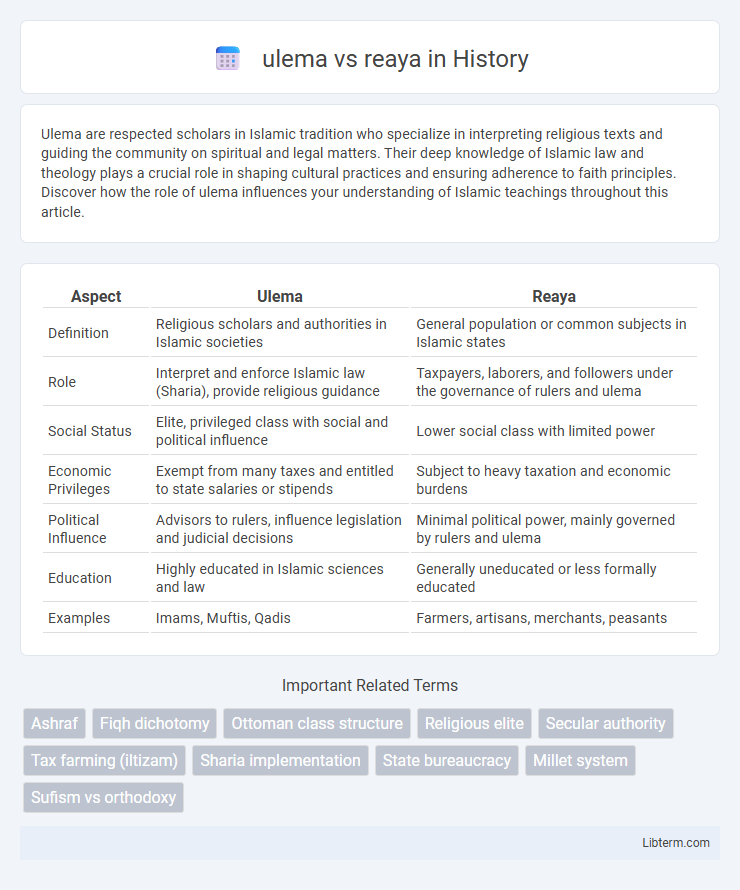Ulema are respected scholars in Islamic tradition who specialize in interpreting religious texts and guiding the community on spiritual and legal matters. Their deep knowledge of Islamic law and theology plays a crucial role in shaping cultural practices and ensuring adherence to faith principles. Discover how the role of ulema influences your understanding of Islamic teachings throughout this article.
Table of Comparison
| Aspect | Ulema | Reaya |
|---|---|---|
| Definition | Religious scholars and authorities in Islamic societies | General population or common subjects in Islamic states |
| Role | Interpret and enforce Islamic law (Sharia), provide religious guidance | Taxpayers, laborers, and followers under the governance of rulers and ulema |
| Social Status | Elite, privileged class with social and political influence | Lower social class with limited power |
| Economic Privileges | Exempt from many taxes and entitled to state salaries or stipends | Subject to heavy taxation and economic burdens |
| Political Influence | Advisors to rulers, influence legislation and judicial decisions | Minimal political power, mainly governed by rulers and ulema |
| Education | Highly educated in Islamic sciences and law | Generally uneducated or less formally educated |
| Examples | Imams, Muftis, Qadis | Farmers, artisans, merchants, peasants |
Introduction: Understanding Ulema and Reaya
Ulema and Reaya represent two distinct social and religious classes in Islamic history, with Ulema comprising the learned scholars and religious authorities responsible for interpreting Sharia law, while Reaya refers to the general population or subjects under Islamic governance. The Ulema held significant influence in judicial, educational, and spiritual matters, shaping religious and social norms. Reaya, as the masses, followed the guidance and rulings established by the Ulema, forming the broader community within the Islamic state.
Historical Origins of Ulema and Reaya
The historical origins of ulema and reaya trace back to the Ottoman Empire, where ulema referred to the scholarly class specializing in Islamic jurisprudence and theology, responsible for religious guidance and legal rulings. Reaya, contrastingly, denoted the mass of subjects or common people who lived under the protection and governance of the state but lacked formal religious authority. This social distinction institutionalized the division between religious elites and lay populations, shaping governance and societal roles throughout Ottoman history.
Defining the Ulema: Roles and Responsibilities
The Ulema are Islamic scholars entrusted with interpreting Sharia law, guiding religious education, and issuing fatwas that influence social and legal decisions within Muslim communities. Their responsibilities extend to preserving religious texts, leading prayers, and advising rulers on moral and jurisprudential matters. This religious elite contrasts with the reaya, or common people, who generally follow the guidance set forth by the Ulema without holding formal religious authority.
Who are the Reaya? Social and Economic Context
The Reaya, historically signifying the lower social class in Ottoman society, comprised peasants, artisans, and merchants who were subject to taxation and governance by the ruling elite. Their economic role was crucial as they sustained agricultural production, trade, and craftsmanship vital to the empire's economy. Socially, the Reaya lacked political power and privileges, contrasting sharply with the Ulema, who held religious authority and often influence within the administrative hierarchy.
Ulema’s Influence in Religious and Legal Affairs
The Ulema hold significant authority in shaping Islamic jurisprudence and religious doctrine, guiding both legal rulings and ethical conduct within Muslim communities. Their expertise in interpreting Sharia law empowers them to influence judicial decisions and societal norms, often acting as advisors to political leaders. This religious elite's role in education and legal institutions ensures the continuity and enforcement of Islamic principles across generations.
The Reaya’s Role in Ottoman Society
The Reaya, comprising the non-elite tax-paying subjects in Ottoman society, played a crucial economic and social role by sustaining the empire through their agricultural labor and tax contributions. This class enabled the state's administrative and military functions, as their taxes funded the Ulema, Janissaries, and governing bodies, maintaining the imperial structure. The dynamic between the Reaya and Ulema reinforced the Ottoman socio-political hierarchy, with the Ulema providing religious legitimacy and the Reaya supporting the empire's material foundation.
Power Dynamics: Ulema’s Authority Over Reaya
The ulema wield significant religious and legal authority over the reaya, shaping social norms and political decisions through their control of Islamic jurisprudence and educational institutions. Their power enables them to interpret Sharia law, influencing governance while maintaining the legitimacy of ruling elites. This dynamic establishes a hierarchical structure where the ulema's influence enforces compliance and reinforces social order within Muslim societies.
Societal Interactions Between Ulema and Reaya
The societal interactions between the ulema and reaya in Islamic societies shaped governance and social order, where the ulema acted as religious scholars and legal authorities while the reaya represented the general populace or subjects. The ulema's interpretation of Sharia law influenced the social norms, education, and judicial processes affecting the daily lives of the reaya, maintaining a hierarchical but interdependent relationship. This dynamic upheld religious legitimacy for ruling elites and ensured that legal and moral frameworks guided communal life and dispute resolution within the reaya.
Transformations in Ulema-Reaya Relations Over Time
The traditional hierarchical relationship between ulema (Islamic scholars) and reaya (common people) has evolved significantly through history, influenced by socio-political changes and modernization. With the rise of centralized states and legal reforms, the ulema's authority in interpreting Islamic law and administering religious affairs gradually shifted, reducing their direct control over reaya. Modern education and communication technologies have empowered reaya with access to religious knowledge, fostering more reciprocal and dynamic interactions between these groups.
Conclusion: Lasting Impact on Islamic and Ottoman Societies
The dynamic between the ulema, Islamic scholars responsible for religious authority, and the reaya, the general populace, shaped governance and social order in Ottoman society. The ulema's influence extended beyond religion into legal and educational institutions, cementing their role in maintaining Islamic law and societal norms. This lasting impact fortified the intertwining of religious leadership and administrative control, profoundly affecting both Islamic tradition and Ottoman political structures.
ulema Infographic

 libterm.com
libterm.com